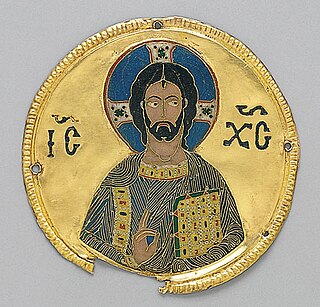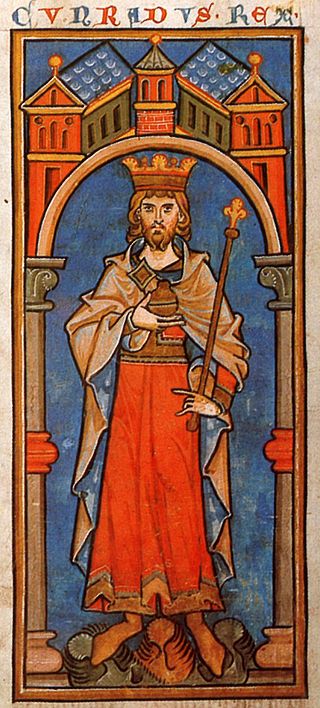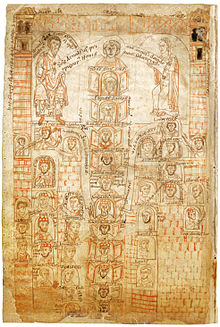
The Concordat of Worms was an agreement between the Catholic Church and the Holy Roman Empire which regulated the procedure for the appointment of bishops and abbots in the Empire. Signed on 23 September 1122 in the German city of Worms by Pope Callixtus II and Emperor Henry V, the agreement set an end to the Investiture Controversy, a conflict between state and church over the right to appoint religious office holders that had begun in the middle of the 11th century.

Otto of Bamberg was a German missionary and papal legate who converted much of medieval Pomerania to Christianity. He was the bishop of Bamberg from 1102 until his death. He was canonized in 1189.

The Croyland Chronicle, also called Crowland Chronicle, is an important primary source for English medieval history, particularly the late 15th century. It is named for its place of origin, the Benedictine Abbey of Croyland or Crowland, in Lincolnshire, England. It was formerly also known as the Chronicle of Ingulf or Ingulphus after its supposed original compiler, the 11th-century abbot Ingulf. As that section of the text is now known to have been a later forgery, its author is instead known as Pseudo-Ingulf. The validity of the source itself has been questioned, partially due to the unknown identity of the original author, and gaps in all continuations of the text. There has also been substantially little effort made to find and translate the original manuscript.

The Investiture Controversy or Investiture Contest was a conflict between the Church and the state in medieval Europe over the ability to choose and install bishops (investiture) and abbots of monasteries and the pope himself. A series of popes in the 11th and 12th centuries undercut the power of the Holy Roman Emperor and other European monarchies, and the controversy led to nearly 50 years of conflict.

Caesarius of Heisterbach, sometimes erroneously called, in English, Caesar of Heisterbach, was the prior of a Cistercian monastery, Heisterbach Abbey, which was located in the Siebengebirge, near the small town of Oberdollendorf, Germany.
Emicho was a count in the Rhineland in the late 11th century. He is also commonly referred to as Emicho of Leiningen or Emich of Flonheim, and not to be confused with Bishop Emicho of Leiningen. In 1096, he was the leader of the Rhineland massacres which were a series of mass murders of Jews that took place during the People's Crusade.

Sigebert of Gembloux was a medieval author, known mainly as a pro-Imperial historian of a universal chronicle, opposed to the expansive papacy of Gregory VII and Pascal II. Early in his life he became a monk in the Benedictine abbey of Gembloux.
Aura Abbey was a house of the Benedictine Order located at Aura an der Saale in Bavaria in the Diocese of Würzburg.
Ekkehard II, called Palatinus, was a monk of the Abbey of Saint Gall who became known for his sequence poetry.

Michaelsberg Abbey or Michelsberg Abbey, also St. Michael's Abbey, Bamberg is a former Benedictine monastery in Bamberg in Bavaria, Germany. After its dissolution in 1803 the buildings were used for the almshouse Vereinigtes Katharinen- und Elisabethen-Spital, which is still there as a retirement home. The former abbey church remains in use as the Michaelskirche.

Christianity in the 12th century was marked by scholastic development and monastic reforms in the western church and a continuation of the Crusades, namely with the Second Crusade in the Holy Land.
Frutolf of Michelsberg was a monk in Michelsberg Abbey in Bamberg, Germany, of which he became prior. He was probably a native of Bavaria.

The Chronica sancti Pantaleonis, also called the Annales sancti Panthaleonis Coloniensis maximi, is a medieval Latin universal history written at the Benedictine monastery of Saint Pantaleon in Cologne. It was written in 1237 and covers the history of the world in a series of annals from Creation down to the year of composition. A continuation down to 1249 was added later. Up to the year 1199 it relies heavily on other sources; from 1200 it is an independent source.

The Chronica regia Coloniensis, also called the Annales Colonienses maximi, is an anonymous medieval Latin chronicle that covers the years 576 to 1202. The original chronicle only went up to 1197, but a continuator later added the following few years' events. According to the historian Manfred Groten, the Chronica was probably first compiled about 1177 in Michaelsberg Abbey, Siegburg, and then continued in Cologne. The earliest manuscript only contains an account down to 1175.

The Sächsische Weltchronik is a universal history written in German prose. It is not clear in which regional form of German the original was written. Of the twenty-four surviving manuscripts, ten are in Low German, nine in High German and five in Central German. These can be divided into three recensions, the earliest dated to 1229 and the latest to 1277.
Oda of Saxony was a Saxon princess. She was the daughter of Otto I, Duke of Saxony and Hedwiga of Babenberg. She married King Zwentibold of Lotharingia and at his death in August 900, she contracted a second marriage with Count Gerhard I of Metz. From this union were born:
Burchard of Ursperg, also called Burchard of Biberach (c.1177–1230/1) was a German priest and chronicler. His Ursperger Chronicle is the most important universal history of the late Staufer era.
Berthold of Zwiefalten was a German Benedictine monk who thrice served as abbot of Zwiefalten Abbey and wrote its early history.

Luitpold was archbishop of Mainz from 1051 to 1059.
Herrand was a German prelate who served as abbot of Ilsenburg and bishop of Halberstadt (1090–1102).












